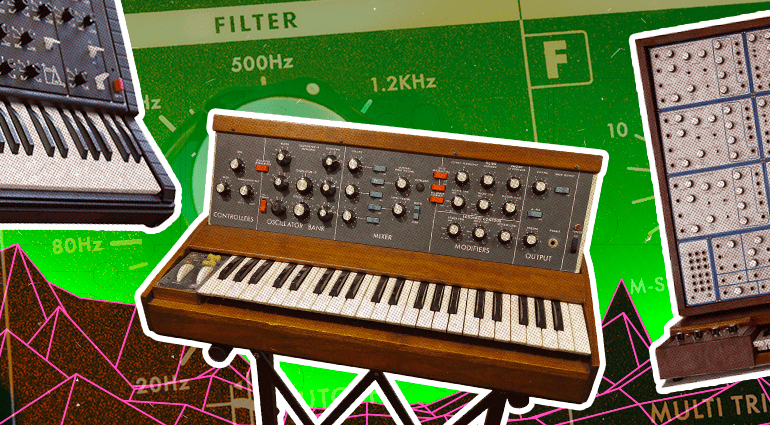
Reducing the history of synthesizers to a few paragraphs is a rather complex operation: like a puzzle, this story is made up of numerous intuitions and inventions developed by brilliant minds over the past two centuries.
Beginnings
Who came up with the idea of this musical instrument? To answer the question we could turn our eyes to the first experiments that connected electricity and sound, like those that Alfred Graham made in 1895 and that led to the genesis of a pioneering voltage-controlled device: the Electric Musical Tones.
Fatalities and… ‘illumination’ also made a great contribution: when called by London’s administration to solve the problem of the buzz created by the voltaic arc lamps that illuminated the streets of the city, William Du Bois Duddell sensed that the audible frequencies emitted by lamps could be controlled by changing the voltage applied to the electrodes. This was 1899. Just let that sink in.
Thus was born the Singing Arc, an electric instrument whose concept was not very far from what will be used in the keyboards of voltage-controlled synthesizers, where the electric voltage is increased or decreased with a ratio of 1 Volt per octave. But to get this far, some Nobel prize winners’ juice was needed…

Synthesizers belong to the family of electronic instruments; to be defined as such, a musical instrument must produce sounds from one or more electronic generators such as valves or oscillators – i.e. devices capable of providing a sinusoidal, rectangular or triangular signal at the output without any specific signal being applied to the input, exploiting the only supply voltage – without the aid of any vibration of an acoustic or mechanical nature.

The annus mirabilis of electronic sound is 1906, the year in which the triode was discovered which, precisely because of its properties of oscillator in audio band, was initially known by the name Audion or thermionic valve. Invented by Lee de Forest, the triode was born from another brilliant idea, namely from the diode of John Ambrose Fleming who had patented it in 1904: if the diode allowed to control current flows, the triode could amplify the electrical signals in entry or generate persistent oscillations.

Development
An intricate path of musical innovations – such as Theremin, Ondes Martenot and Trautonium – leads us to the RCA Mark II Sound Synthesizer, a device purchased by Columbia University in New York in 1957 and built starting from 1951 by engineers Herbert Belar and Harry Olson of the Bell Laboratories.
Considered the first electronic sound production system that automated oscillators and modules connected to it, it made possible to control the height, intensity and timbre of the sound through a protocol imprinted by the composer on a roll of perforated paper; the sound was generated by twelve sinusoidal oscillators and the waveform could be modulated and processed through the filters. The Mark II was far from being an easy-to-use tool and occupied an entire room with its size: its monstrous size owes its nickname, Victor (from Frankenstein, of course!).

The most summarised texts dedicated to the realm of synthesizers often leave out some important examples that preceded the development of the Mark II, such as the optical synthesizers developed in Russia since the 1920s – see Yevgeny Murzin’s ANS conceived since 1937 – or the Electronic Sackbut (1945 – 1948) by the Canadian Hugh Le Caine, considered by many to be the progenitor of the voltage-controlled synthesizers.
The transistor was undoubtedly a fundamental ingredient for the birth of increasingly performing and marketable synthesizers on a large scale. Heir of the triode, it was conceived in 1947 at the Bell Laboratories by Walter H. Brattain, John Bardeen and William Schockley, awarded the Nobel Prize for Physics in 1956. In 1951, the new electronic component will facilitate the dynamics of voltage control and open the way to miniaturisation.
With voltage control, the increase or decrease in electrical voltage allows the synthesis of sound in its frequency, timbre, waveform and intensity components; through control circuits that make different voltages available, generation and sound processing are managed. The different sound production and control devices (modules) will be connected to each other in units, and this practice will create the famous modular synthesizers.
Bob Moog: synth becomes popular

Robert A. Moog had borrowed the modular structure, the voltage control strategy and the interest in transistor-based devices from the instruments and reflections of Hugh Le Caine, Raymond Scott and Harald Bode; so it was that in 1964 he presented his Voltage-Controlled Music Modules in New York, imagining the development of devices capable of allowing the musician more agility in the compositional and execution phase, paying particular attention to the aspect of live production.
Fertile subject of discussion of coeval electronic engineering, voltage control technology was not invented by Moog, often cited as the father of synthesizers, but he was responsible for the popularisation of this system obtained thanks to the immediate success of Moog products on the mass market. The increase in control capabilities in sound production and ease of use made Modular Moog products truly innovative.

While Bob Moog was preparing to start a revolution in the world of electronic synthesis by applying a keyboard to its modules and attempting to solve the three main problems of the electronic composer – size, stability and control of the instrument – on the opposite coast of the United States another group of people developed the potential of voltage control. At the San Francisco Tape Music Center, composers Ramon Sender and Morton Subotnick were experiencing the limitations of the equipment then available; the two turned to Donald Buchla and the 100 series Modular Electronic Music System, better known as the Buchla Box, was born from the need to streamline the compositional operation.
In Italy research on synthesizers proceeded following the stimulus of voltage controls: Paolo Ketoff, who had already conceived the Fonosynth in 1958, made the portable SynKet synthesizer in 1963.
Slightly ahead of Moog and Buchla, Peter Zinovieff was also investigating the possibilities of voltage control in England; a few years later, in 1969, he gave life – alongside Tristram Cary and David Cockerell – to the famous EMS VCS 3 and to the subsequent models so loved by the protagonists of rock and psychedelia (does the intro of On the Run by Pink Floyd tell you anything?). Around the same time, the jazz composer Sun Ra was starting to use another small portable synth, the Model B, one of the first prototypes of the Minimoog.
Although both were extremely compact instruments, Minimoog and VCS 3 were radically different, starting with the keyboard, absent in the first version of VCS 3 as a medium devoted to atonal music and the generation of sound effects; other details placed the two machines at the antipodes: for its connections, the EMS VCS 3 did not use dozens of cables introduced into the front panel but small pins to be inserted in the matrix placed on the horizontal control surface of the machine. The Minimoog, on the other hand, was completely hard–wired.

Japan joins the market
The sixties therefore saw new musical means expand in different geographical areas, all united by the exploitation of voltage control, by the small size of the instrument and by the possibility of listening in real time to what was being produced.
As already mentioned, this fascinating story is long and tortuous: we have mentioned a few names and added some tiles to our puzzle but we have also left out many other important innovators: what about a market giant like Korg who broke into this electronic jungle with the first drum machine in the sixties, giving life to the famous MS Series? Over the years, the development of technologies darted faster and faster, from Yamaha‘s FM synthesis to Roland‘s successful products.

The synthesis-sound invasion
Grammy Award Winning Masterpieces such as Switched-On Bach (1968) – the remake of classical music pieces created with Moog modules by Walter–Wendy Carlos – contributed to making musicians understand the infinite possibilities offered by the new instruments. In a flourishing of experiments, the synthesizers soon burst into all musical genres: from the spatial sounds of Dave Brock‘s VCS3 with Hawkwind to the dilated atmospheres of the Kosmische Musik (Klaus Schulze certainly earns a mention, if only for the vastness of his set-up) to the universe of jazz which saw MiniMoog and ARP Odyssey parading among Herbie Hancock and Chick Corea.
The Beatles also knelt before the synthesizer god: in 1969 George Harrison ordered his Moog in New York and barely had time to insert it in four songs in the final mix of Abbey Road (Maxwell’s Silver Hammer, I Want You (She’s So Heavy ), Here Comes the Sun and Because).
You are currently viewing a placeholder content from Youtube. To access the actual content, click the button below. Please note that doing so will share data with third-party providers.
Without the synthesizers we would never have heard songs such as Donna Summer and Giorgio Moroder’s I Feel Love nor the characteristic Kraftwerk vocoders, who created the Autobahn vocal lines with an EMS prototype.
You are currently viewing a placeholder content from Youtube. To access the actual content, click the button below. Please note that doing so will share data with third-party providers.
The synthetic sound did not spare anyone, not even the world of cinema that had exploited, since their birth, the first instruments of the future, such as the Theremin and the Ondes Martenot. In the world of effects and soundtrack production, the new sounds were immediately pigeonholed in a precise register of emotional correspondences: they evoked hidden forces, ghosts, altered psychological states or dangerous situations and possible worlds in distant galaxies. Remember the ARP2500 of Close Encounters of the Third Kind with its sequence of notes for communication between humans and aliens?

The importance of musicians
In this fascinating story, musicians were not limited to being mere users or passive promoters of the instruments; more often than not, the new devices and their improvements arose from the forward-looking demands of the composers.
To cite just a few examples, it was thanks to a request from the Australian composer Don Banks that Zinovieff, Cockerell and Cary invented in 1967 a modular voltage controlled instrument – the Voltage Controlled Studio Mark One (VCS1) – thus starting the gestations of the famous VCS3. Few know the fundamental role of Wendy Carlos in the improvement of the Moog modular systems: his needs led to the introduction of the touch sensitive keyboard, a special form of graphic equalizer and the portamento function.
The latter will be one of the favorite features of Keith Emerson who, with his Monster Moog, will represent much more than excellent advertising for the products of the Trumansburg brand. Emerson was among the first to understand the importance and the potential of portamento, the pitch bending and the ribbon controller, functions capable of overcoming the limit imposed by the monophonic keyboard while creating a real style.
For a long time, Emerson would be one of the main icons of Moog and his image will often be used in the promotional campaigns of the American brand. Like many other talented innovators, Emerson will also act as a tester for the company, previewing new features on the Constellation synth suite (1972-74) and providing advice to the company’s technicians on the improvements to be applied to Moog products.

From Eurorack to miniaturisation
Thanks to the Eurorack format, coined by Doepfer in 1996 and now a dominating force in the market, the electronic synthesis in its modular aspect lives a thriving renaissance and offers its many users a multitude of excellent brands: from proven giants, such as the aforementioned Doepfer, to small companies like Frap Tools.
The rediscovery of the analog thrill is no longer a business destined for a few: lovers of Moog’s Model D, for example, can now experience the thrill of the three oscillators in Behringer‘s version while admirers of the sounds of the Korg MS-20 can count on a new lighter version, cheaper and in step with the times.
“Miniaturising” seems to be one of the watchwords of the world of contemporary synthesizers: from Arturia’s Microbrute to the Korg Volca line, the dimensions are getting smaller and smaller, backpack friendly, without neglecting the sound experience and the different possibilities of creative combination.

Wanna know more about Synth? Check out our YouTube channel, Thomann Synthesizers
You are currently viewing a placeholder content from Youtube. To access the actual content, click the button below. Please note that doing so will share data with third-party providers.
Are you a synth addict? Do you like analog synthesizers? Let us know with a comment!
Article originally written by Johan Merrich in Italian
5 comments
Leave a Reply
You are currently viewing a placeholder content from Facebook. To access the actual content, click the button below. Please note that doing so will share data with third-party providers.
More InformationYou are currently viewing a placeholder content from Instagram. To access the actual content, click the button below. Please note that doing so will share data with third-party providers.
More InformationYou are currently viewing a placeholder content from X. To access the actual content, click the button below. Please note that doing so will share data with third-party providers.
More Information

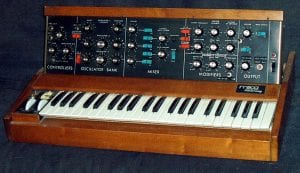
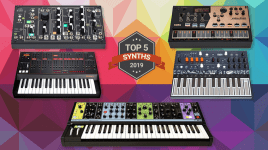



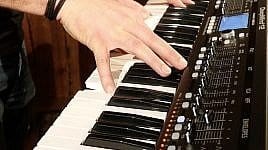
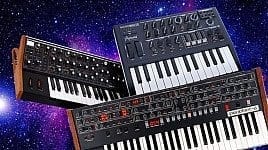
Jerry Summers says:
From your otherwise excellent article, “The annus mirabilis of electronic sound is 1906, the year in which the triode was discovered…”
Sorry, but the triode was *invented* not discovered.
The structure of DNA was discovered, the light bulb was invented.
Andy beagle says:
Well, to be pedantic, you “discover” what works well with what to invent something…?
Adam says:
A wonderful article! Yet, mentions nothing about Harold Bode and the Audio System Synthesizer. In 1959.
Bode’s new (new at the time) idea to create a modular device where different components could be connected as needed; and in doing so created the first voltage controlled modular synthesizer – a concept that was copied later by Robert Moog and Donald Buchla amongst others. The resulting instrument, the Audio System Synthesizer, allowed for connection of separate modules such as Ring modulators, Filters, Oscillators, etc in any order to modify or generate sounds. The first voltage controlled modular synthesizer.
Harold Bode with key.
Tom Rhea says:
Although Harald Bode should be revered as a pioneer, the patent for his “Sound Synthesizer” of 1960-1961 shows that there were NO voltage controlled modules therein. Gee, the simple fact that no control inputs are evident should be a tipoff! Don’t argue. Look at the patent!
Tom Rhea says:
Harald Bode’s 1962 US Patent is numbered 3,069,956 and refutes the notion that Harald had voltage controlled modules in his Sound Synthesizer. If you want to see what it actually looked like, see Electronics magazine December 1, 1961.